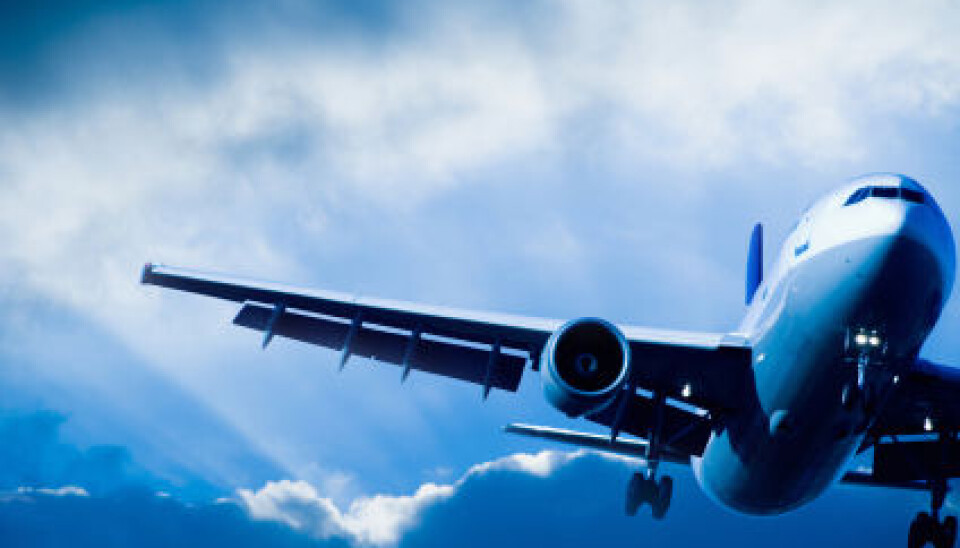
Safer flights for COPD patients
A new method makes it simpler for patients with chronic obstructive pulmonary disease (COPD) to know whether they need extra oxygen during flights.
Denne artikkelen er over ti år gammel og kan inneholde utdatert informasjon.
For some persons, fear of crashing, claustrophobia and irritating fellow passengers are not the biggest issues they have with flying.
While cruising at 10,000 metres or so, cabins in commercial aircraft will typically duplicate the air pressure found at an altitude of around 2,100 metres. For those of us who spend most of our lives close to sea level, this means our blood oxygen levels will drop. This can be a problem for travellers who suffer from chronic lung diseases.
Many patients with COPD risk acute shortness of breath and insufficient oxygenation when flying in jets at cruising altitudes.
This is not only terribly uncomfortable for these passengers. It can complicate their conditions.
Cabin crew are equipped with portable oxygen dispensers. Inflight oxygen supplements are recommended internationally when lower air pressure makes oxygen levels in the blood drop beneath a certain limit.
But it’s hard to quantify or predict the effect of cabin pressure on the oxygen levels of any given COPD patient.
Cheap and available
Anne Edvardsen, a bioengineer and researcher at the Norwegian hospital Glittreklinikken, has discovered an easy way of detecting which patients require inflight oxygen supplements.
She has developed a method involving the measurement of oxygen saturation in the blood of patients, both when walking and at rest. The method uses standard medical technology, sensors called pulse oxymeters.
“If a patient with a lung disease asks a doctor whether he or she is fit to fly the physician has no way of predicting whether the patient will require supplemental inflight oxygen,” explains Edvardsen.
“By using cheap, available methods, and by combining them, we can now provide a certain diagnosis of who needs to travel with supplemental oxygen and who doesn’t need to.”
Her method is also easier and more available than other, more comprehensive tests.
Added to international guidelines
Edvardsen says the new method can sort out which patients don’t need the extra oxygen on aircraft.
“Equations applying to lung function and blood oxygen levels have been devised using mathematical tools. But these were developed with whole groups in mind. Such lung problems vary individually and the results can come out wrong. Lots of patients who don’t need oxygen were getting it,” she says.
The new method of measurements sorts out the many patients, two-thirds in all, who don’t require the more extensive test formerly in use.
The results of Edvardsen’s research have now taken into account in international guidelines for patients who plan to travel by air.
Seven-fold risk
A quarter of a sample of around 400 Norwegian COPD patients had experienced shortness of breath –dyspnea – during flights in the course of a two-year period. Thus, they had a seven-fold risk of experiencing dyspnea against the risk for healthy passengers.
There’s a clear link between COPD and dyspnea during flights. But there has been not certitude regarding whether such shortness of breath is linked to low blood oxygen levels.
This was relationship tested by having a group of patients who had reported experiences of dyspnea when flying to breathe air regulated to oxygen levels corresponding to that in aircraft cabins.
It turned out that the breathing problems occur independently of low oxygen levels in the blood.
“If oxygen levels in the blood drop acutely, the body compensates with greater ventilation. But the point where this is triggered varies significantly from person to person,” explains Edvardsen.
“Pulmonary patients who breathe more rapidly have trouble emptying their lungs. They overfill them with air and use other muscles than normal, which causes the experience of shortness of breath.”
A big demand
Although Edvardsen and her colleagues found no connection between low blood oxygen levels and shortness of breath, the administration of supplemental oxygen made the patients’ dyspnea go away.
Edvardsen says it is hard to explain exactly why this effect occurs, because shortness of breath can have multiple causes.
As variations of breathing difficulties are very individual, dyspnea is not a good indication of insufficient blood oxygen levels. This makes the need for accurate tests all the more important.
“In another light, even though we can say that breathing problems are not a good indicator of something serious, we want to avoid anything critical happening to patients. So this means these are good tests,” says Edvardsen.
Referances
Anne Edvarsen: Flying with chronic obstructive pulmonary disease. Prevalence og symptoms, pre-flight assessment and in-flight oxygen. University of Oslo, 2013.
Translated by: Glenn Ostling
































